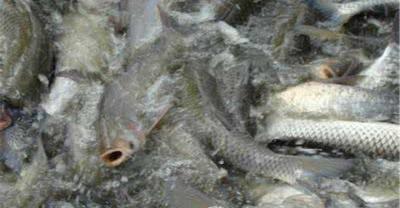How to regulate aquaculture when there is "old water" in the pond
Most of the "old water" often found by aquaculture farmers is copper green or dark green, and when it is more serious, it turns yellow, brown or grayish blue, the water quality is thick and mixed, the transparency is less than 20cm, the dissolved oxygen is low, and fish are easy to float. There is no diurnal change in water color, and there are a large number of phytoplankton in the water, but most of them are indigestible cyanobacteria and other species. The mass reproduction of phytoplankton results in a high pH value of the pond water, which is not conducive to the growth of fish.
1. Clean up the pond
After a year of farming in Tangkou, the bottom will accumulate silt containing a lot of organic matter and bacteria. Therefore, after the end of each culture, it is necessary to carry out silt removal, disinfection, removal of ammonia nitrogen, nitrite and other harmful substances to achieve the purpose of improving water quality.
2. Quicklime is prohibited.
When the water quality of the fish pond is in the state of old water, the use of quicklime to improve the water quality should be prohibited. Because quicklime can further increase the pH of pond water, thus accelerating the excessive reproduction of cyanobacteria.
3. Add and change fresh water
Changing water is an effective way to solve the aging of pool water. The new water injected must be of good quality, pollution-free and rich in dissolved oxygen. The number of times to add and change water should be flexibly controlled according to the principle of looking at the sky, water color and transparency.
4. Turn on the aerator
According to the principle of "three open and two do not open", the aerator should be used reasonably to increase dissolved oxygen in water, promote material circulation, transform and decompose harmful substances at the bottom of the pool.
5. Scientific contribution
In order to reduce the feed coefficient of fish and reduce the pollution of feed to water quality, the compound pellet feed from regular manufacturers should be selected. No organic fertilizer, less nitrogen fertilizer, and appropriate application of phosphate fertilizer according to the water quality of the pond.
6. Transplant aquatic plants
Transplanting aquatic plants such as water hyacinth and water peanut in fish pond can not only reduce ammonia nitrogen and other harmful substances in water, but also absorb nitrogen and phosphorus in water, dilute water fertility and improve water quality.
7. Application of water quality improver or microecological preparation
In the pond mouth where the water source condition is not good or it is difficult to change water, water quality improvers or microecological agents should be applied regularly in the process of culture, which can increase dissolved oxygen at the bottom of the pond, degrade harmful substances and improve the water environment.
8. Raise filter-feeding fish
Adding appropriate amount of filter-feeding silver carp, bighead carp and allogenic silver crucian carp can effectively control the excessive growth of cyanobacteria and other phytoplankton and reduce the content of organic debris in the pond.
- Prev

How to raise succulent little red clothes in summer
What Little Red clothes fears most is summer. The most important secret to spend summer is shade and ventilation. Fundamentally speaking, it depends on the adaptability of the plant itself.
- Next

Post station for farmers: biological characteristics and pond culture techniques of freshwater crayfish
Nowadays, the cultivation of freshwater crayfish has attracted much attention. With the stability of crayfish prices in the domestic market, it has also been recognized by farmers, which is scientific in this process.
Related
- On the eggshell is a badge full of pride. British Poultry Egg Market and Consumer observation
- British study: 72% of Britons are willing to buy native eggs raised by insects
- Guidelines for friendly egg production revised the increase of space in chicken sheds can not be forced to change feathers and lay eggs.
- Risk of delay in customs clearance Australia suspends lobster exports to China
- Pig semen-the Vector of virus Transmission (4)
- Pig semen-the Vector of virus Transmission (3)
- Five common causes of difficult control of classical swine fever in clinic and their countermeasures
- Foot-and-mouth disease is the most effective way to prevent it!
- PED is the number one killer of piglets and has to be guarded against in autumn and winter.
- What is "yellow fat pig"? Have you ever heard the pig collector talk about "yellow fat pig"?

